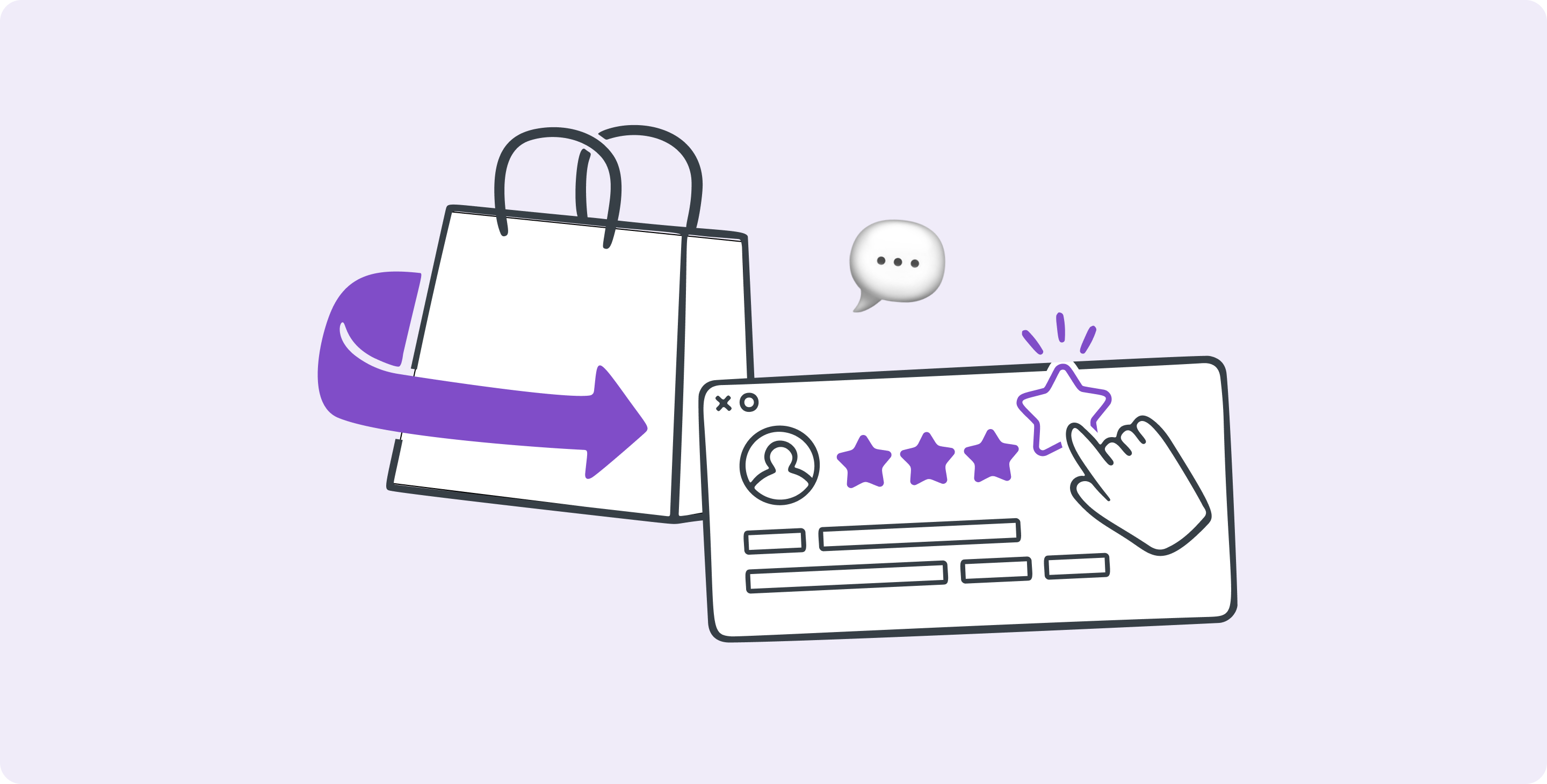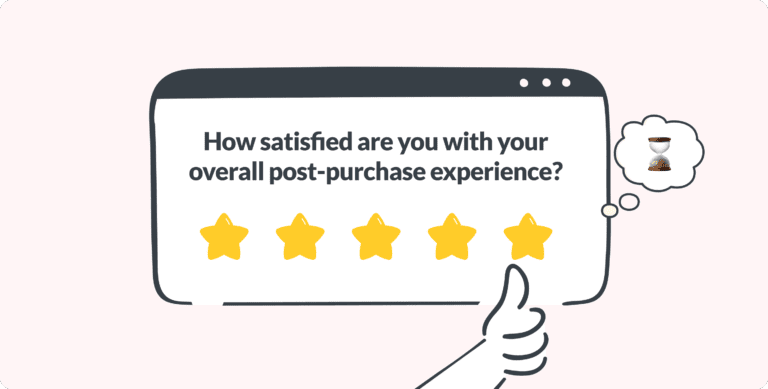Staying ahead of customer feedback trends is essential. By anticipating and responding to evolving customer expectations, you can turn feedback into long-term loyalty while strengthening your reputation and revenue.
Let’s take a look at some current feedback trends.
1. Real-time feedback for immediate action
Customers expect instant solutions, and businesses that can respond quickly to feedback gain a competitive edge.
Traditional feedback collection methods—such as satisfaction surveys sent days later—are being replaced by real-time feedback tools integrated directly into customer interactions.
💡 Implement mobile-friendly surveys that capture feedback instantly.
💡 Use AI-driven chatbots to address concerns as soon as they arise.
💡 Automate alerts for negative feedback so teams can act immediately.
Example — An online merch store deploys a post-purchase CSAT survey at checkout, allowing customers to rate their experience immediately.
Low ratings trigger an immediate response from customer service, improving issue resolution and encouraging repeat purchases.
2. AI-driven sentiment analysis for deeper insights
Manually analyzing feedback is time-consuming and often misses critical patterns. AI-driven sentiment analysis tools can process large volumes of customer responses, identifying trends and emotions behind feedback.
💡 Gain deeper insights into customer sentiment beyond numerical survey scores – let the customer tell you in their own words what they care about.
💡 Use AI to detect recurring pain points and address them proactively.
💡 Personalize customer interactions based on sentiment trends.
Example — A subscription box service tracks sentiment in cancellation feedback. AI detects that many customers mention “too many similar products.” The company adjusts its curation strategy, leading to higher retention and fewer cancellations.
3. Personalized customer engagement based on feedback
Generic responses to customer feedback no longer suffice. Leading brands personalize follow-ups, making customers feel valued and heard.
💡 Customize responses based on both individual feedback and customer history: when reaching out, your team should consider how long the customer has been shopping with you, and whether they had complaints in the past.
💡 Offer personalized discounts or loyalty incentives to dissatisfied customers.
💡 Close the feedback loop by informing customers about implemented improvements.
Example — A premium wine club responds to VIP members who leave lukewarm reviews. Instead of a generic response, the company sends a curated bottle selection based on the customer’s past favorites, along with an invitation to an exclusive virtual tasting event.
Read more: What to do about dissatisfied customers?
4. Omnichannel feedback collection for a complete picture
Customers interact with brands across multiple touchpoints—stores, websites, social media, and customer service channels.
Gathering feedback from all these sources ensures a more comprehensive understanding of the customer experience.
💡 Deploy surveys via email, SMS, website pop-ups, and live chat.
💡 Consolidate feedback from social media mentions and online reviews.
💡 Integrate feedback data across all customer engagement platforms for a unified view.
Example — A sporting goods store reviews CSAT scores from email ticket surveys, which initially indicate positive feedback. After introducing surveys on WhatsApp, they see a higher response rate and more immediate, candid feedback. This uncovers previously overlooked frustrations, prompting the company to enhance product listings with more detailed specs and video demos.
5. Predictive analytics to enhance customer experience
In addition to reacting to feedback after the fact, consider using predictive analytics to anticipate customer needs and prevent issues before they arise.
💡 Behavior-based engagement triggers for customer retention – Identify patterns in customer behavior that indicate readiness for upsells, renewals, or proactive intervention. Tools like HubSpot Lead Scoring detect churn signals or buying intent, enabling personalized outreach at just the right moment.
💡 Forecast demand for better inventory management – Prevent stockouts or overstocking by using predictive analytics to anticipate demand fluctuations based on historical sales data, seasonality, and external factors.
💡 Intelligent routing for customer support efficiency – Predict the complexity of an inquiry using AI-powered sentiment analysis and route it to the most appropriate agent. Platforms like Salesforce Einstein Analytics use predictive analytics to match customer issues with the right expertise, reducing response times and improving resolution rates.
💡 Create personalized offers based on dynamic pricing optimization. Your business can use tools like Pricefx or Dynamic Yield to analyze market trends, competitor pricing, and individual customer behaviors in real time. By adjusting prices dynamically, you ensure competitive yet profitable pricing.
💡 Anticipate product failures before they happen. Leverage machine learning to monitor usage patterns and detect early warning signs of potential product defects or service disruptions. Notify customers before an issue arises; offer proactive support if the failure can’t be avoided.
Example — A grocery chain analyzes past customer feedback and seasonal trends to predict peak hours. They adjust staffing levels accordingly, reducing wait times and improving customer satisfaction.
6. Transparency in customer feedback handling
Consumers appreciate brands that actively listen and implement changes based on their feedback. Transparency fosters trust and strengthens customer relationships.
💡 Publicly address customer concerns and outline steps taken to resolve them.
💡 Share improvements made in response to customer feedback.
💡 Encourage customers to participate in co-creation initiatives (e.g., voting on product updates).
Example — Starbucks launched the Back to Starbucks plan to highlight changes like personalized service, ceramic mugs, a simpler menu, and better mobile ordering. The company openly communicated these updates, showing customers their feedback was shaping the brand’s future.
Embrace the future of customer feedback with the right tools
Retailers that adopt these feedback trends will be better positioned to enhance customer experiences, drive loyalty, and maintain a competitive edge. Investing in real-time feedback systems and personalized engagement transforms feedback from a routine process into a powerful growth strategy.
Find out how Simplesat helps you keep up with evolving customer expectations.
About Simplesat: Simplesat is the leading omnichannel survey app designed to enhance customer feedback management across various platforms, including Zendesk, Salesforce, and Gladly. Trusted by businesses worldwide, Simplesat delivers actionable insights that drive business growth and customer satisfaction.















